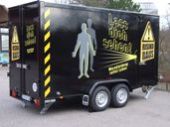
Development of an interactive exhibit for good visibility on the roads
Project No. IFA 0093

Exhibit for good visibility, Picture: DGUV
Status:
completed 03/2010
Aims:
Road safety, on journeys to and from work or school and at the workplace, is a topic of the prevention campaign with the title "Fight the Risk", which is being conducted in 2010 and 2011 by the German accident insurance institutions. Experts estimate that the number of serious and fatal road injuries suffered by pedestrians and cyclists could be reduced by around 50% if the visibility of these road users could be increased. The assumptions that "anyone I can see, can also see me" and "with light clothing, I can easily be seen" are widespread, but only partly valid. Even light outdoor clothing will be noticed so late that a car travelling at only 70 km/h will not be able to brake in time. Retroreflective high-visibility clothing and accessories provide a particularly high level of protection. These reflect most of the light back to the source and thus ensure substantially better visibility than normal outdoor clothing, for example, which reflects light in all directions. The use of retroreflective high-visibility clothing continues to be the exception, however. The objective of the project was to develop an interactive exhibit for the campaign and beyond: one which could be used by the accident insurance institutions during events for the general public in order to raise awareness of the important subject of good visibility on the roads.
Activities/Methods:
In order to demonstrate the particular effectiveness of high-visibility clothing and/or special retroreflective objects compared to normal outdoor clothing, the concept of a mobile, walk-in "darkroom" was created. Life-size child and adult dummies and other objects important for visibility, such as schoolbags and bicycles, can be presented in the darkroom. A special optical system simulates distances of up to thirty metres from the viewer. At the same time, the viewer can produce different lighting conditions simply by turning a rotary switch: from daylight, through dusk, to night conditions. The resulting conditions are true to life, enabling the viewer to experience directly the good or extremely poor visibility of various forms of outdoor clothing: dark and light, high-visibility clothing, and various objects which influence visibility.
Results:
The concept was implemented in the form of a walk-in box trailer with dimensions (H x W x L) of 2 m x 1.6 m x 4 m. The associated slogan is: "Let's see you! High-visibility clothing saves lives." The trailer is entered by a fold-down step. Viewers find themselves in front of a mock car windscreen. Through it, they look through an optical facility into the interior of the vehicle, where they see groups of people at different distances and under variable lighting conditions, which they can select. They thus have an immediate impression of the visibility of the individual people as a function of their clothing/accessories. The contents of the vehicle can be varied, according to the event at which the exhibit is being used. Groups of life-size child and adult dummies are available, as are various accessories for them: dark outdoor clothing, light outdoor clothing, special high-visibility clothing, retroreflective accessories and objects, and also a bicycle with special spoke reflectors. Further accessories can be added according to the target group. The exhibit is available on loan from the IFA for public events and for training courses run by the accident insurance institutions and their partner bodies. A display and a leaflet on the subject of visibility are also available.
Last Update:
22 Mar 2012Project
- Institut für Arbeitsschutz der Deutschen Gesetzlichen Unfallversicherung (IFA)
-cross sectoral-
Type of hazard:mechanical hazards
Catchwords:Unfallverhütung, Kommunikation/Information/ Kampagnen
Description, key words:visibility, high-visibility clothing, retroreflection, accident prevention, road users, commuting accident, way to school